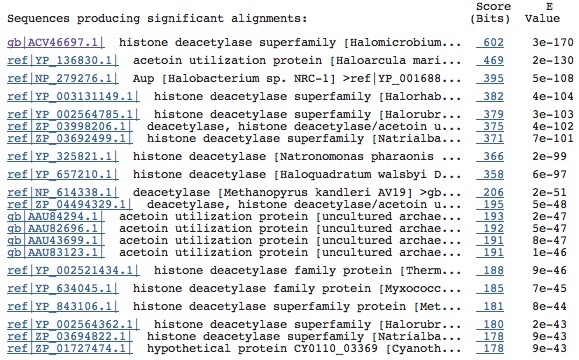Cellulase (Karen Hasty)
Cellulase, Gene 644031540 Accession Number: ZP_03873981
What is cellulase?
Cellulase is a family of enzymes that break down cellulose or the main component of plant cell walls. Cellulose is also sometimes secreted by bacteria in order to form biofilms. It is interesting to note that the wikipedia explanation of cellulase states that all other kinds of organisms (eukaryotes, plants, bacteria, and fungi) have this enzyme, yet nothing is mentioned about archaea. Regardless, JGI has called a gene cellulase in our species, and now we must decide whether this gene was called correctly. If it is called correctly, why would an archeae species have cellulase? Are these organisms secreting this enzyme in order to degrade plant cells to gain energy from these cells or is something else entirely going on?
Shine-delgarno sequence
7 bases upstream of this gene the sequence 'TCTCGGC' appears which may function as the shine delgarno sequence for this gene. This gene does not seem to be in the middle of an operon based on the genes upstream of it (these gene have an open reading frame facing the opposite direction of this gene's reading frame), so a shine-delgarno sequence ought to be present.
Blastx
There are many significant matches to other cellulase and peptidase genes in other species.

What is peptidase?
Since many of the blastx results came up as peptidases, it would be useful to know more about this enzyme. According to answers.com, a peptidase is "An enzyme that catalyzes the hydrolysis of peptides into amino acids." In a previous study by Cottrell, Yu, and Kirchman, the authors noticed similarities between peptidases and cellulases in a blast search. In a wet lab, the ability of the identified cellulase in their organism was investigated for the ability to degrade proteins. The results of the study showed peptidase activity but not cellulase activity! It is possible that JGI has mistakenly identified a cellulase that is actually a peptidase! I think the only way to concretely proove this, however, is to repeat the wet lab experiments that were performed in the Cottrell, Yu, and Kirchman study.
GC Content
The GC content of this gene is 66%, which is identical to the overall GC content of our organisms genome. This fact implies that this gene is not an alien gene.